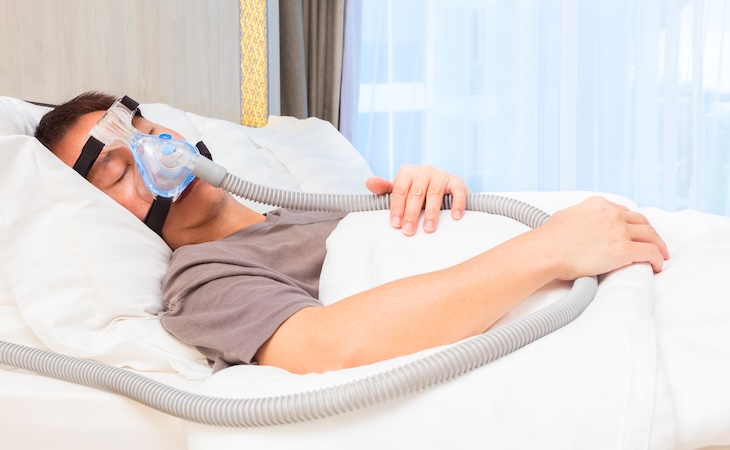
Sleep Disorders & Conditions, Sleep Health
May 20, 2025
Hypopnea: The Little-Known Sleep Disorder That Should Be on Your Radar
Written by Deanna deBara

Hypopnea is a sleep disorder causing partial airway blockage and reduced airflow, leading to poor sleep and daytime fatigue. It differs from apnea, which involves a complete breathing stoppage. Causes include excess weight, neurological conditions, and alcohol use. Diagnosis requires a sleep study, and treatment ranges from lifestyle changes to CPAP therapy.
There are a lot of sleep disorders out there that can be a barrier to getting the rest you need to feel and function your best. This includes sleep apnea, which is arguably one of the most common and well-known sleep disorders.
But there’s a lesser-known relative of sleep apnea that could be causing issues with your sleep (and health!) without you even knowing it—and it’s called hypopnea.
Let’s take a dive into everything you need to know about this disorder, including a hypopnea definition
What is hypopnea?
First things first: What is a hypopnea—and what does hypopnea mean?
“Hypopnea is when your breathing becomes shallow or slows down during sleep with partial blocking of your airflow, lasting at least 10 seconds,” says Shelby Harris, PsyD, director of Sleep Health at Sleepopolis. “It reduces airflow and can drop your oxygen levels, often leaving you feeling tired or groggy the next day.”
If it sounds similar to sleep apnea, it’s because, in some ways, it is (more on that later)—and they often go hand-in-hand. “[Hypopnea is] usually part of sleep-related breathing disorders like sleep apnea.”
“Hypopnea is when your breathing becomes shallow or slows down during sleep with partial blocking of your airflow, lasting at least 10 seconds. It reduces airflow and can drop your oxygen levels, often leaving you feeling tired or groggy the next day.”
– Shelby Harris, PsyD, director of Sleep Health at Sleepopolis
Types of hypopnea
There are three main types of hypopnea: obstructive, central, and mixed.
Obstructive hypopnea
As the name suggests, obstructive hypopnea happens when something is physically getting in the way of (or, in other words, obstructing) your breathing.
“Obstructive hypopnea happens when something physically blocks your airway, like relaxed throat muscles,” says Harris.
Central hypopnea
Central hypopnea is more of a neurological issue. “Central hypopnea is less common and occurs when the brain doesn’t send the right signals to control your breathing,” says Harris.
Mixed hypopnea
As the name suggests, “Mixed hypopnea occurs when there’s a combination of both central and obstructive,” says Harris.
Hypopnea vs. sleep apnea: What’s the difference?
As mentioned earlier, there are significant similarities between hypopnea and sleep apnea.
“Both hypopnea and apnea disrupt breathing during sleep and lower oxygen levels, leading to poor-quality rest,” says Harris.
However, there’s one key difference. “The main difference is that apnea involves a full stop in breathing, while hypopnea is more of a partial reduction in airflow.”
Again, it’s possible (and, in fact, fairly common) to experience hypopnea and sleep apnea.
“Hypopneas can exist within the spectrum of sleep apnea—when someone might have full apneas and hypopnea,” says Harris.
What are the symptoms of hypopnea?
Hypopnea happens while you’re asleep—but you’ll feel the impact during your waking hours.
According to Harris, common hypopnea symptoms include:
- Daytime fatigue
- Snoring
- Feeling like your sleep wasn’t restful
“You might also wake up with headaches, use the bathroom a lot at night, notice sexual dysfunction, or have trouble focusing during the day,” says Harris.
What causes hypopnea?
What causes hypopnea? That depends on what type of hypopnea you’re dealing with.
“For obstructive hypopnea, causes can include things like excess weight, enlarged tonsils, or nasal issues,” says Harris. “Central hypopnea is tied to conditions that affect how the brain controls breathing, like neurological disorders or heart failure.”
There are also a number of factors that may increase your risk of hypopnea.
“Several factors raise the risk, such as being overweight, smoking, drinking alcohol before bed, or having a family history of sleep disorders,” says Harris. “Structural traits like a narrow throat or recessed chin can also play a role.”
Because mixed hypopnea is a mixture of both obstructive and central hypopnea, the causes and risk factors are also mixed.
How is hypopnea diagnosed?
When it comes to diagnosing hypopnea, “The gold standard is a sleep study, where your breathing, oxygen levels, and other metrics are tracked overnight,” says Harris. “This helps specialists determine if you have sleep apnea or any other sleep disorder.”
What is the apnea-hypopnea index?
How do the specialists determine if you have a sleep disorder like hypopnea? They’ll use what’s known as the apnea-hypopnea index (AHI).
What is the hypopnea index, exactly? The AHI is a scale for diagnosing sleep disorders. Sleep specialists will use the data from your sleep study to measure the number of apneas and hypopneas you experience while sleeping—then compare your results to the AHI metric to determine if you have a diagnosable sleep disorder (and, if you do, at what level of severity).
For adults, the apnea-hypopnea index is divided into four categories:
- Normal: less than five events per hour
- Mild: at least five events per hour but less than 15
- Moderate: at least 15 events per hour but less than 30
- Severe: more than 30 events per hour
These categories are tied to the severity of the sleep disorder; for example, if you have fewer than five events per hour, you don’t have hypopnea or sleep apnea—while if you have 17 per hour, you’d be diagnosed with moderate hypopnea and/or sleep apnea (depending on the events).
How is hypopnea treated?
You know what hypopnea is as well as the symptoms, causes, and risk factors. You know how hypopnea is diagnosed. Now, let’s jump into how it’s treated.
“Treatment [for hypopnea] depends on the cause and severity,” says Harris.
Sometimes, hypopnea can be treated by adopting a healthier lifestyle. “Lifestyle changes like weight loss or avoiding alcohol can help,” says Harris.
But often, patients need more targeted treatments to effectively address hypopnea—and get their sleep back on track.
“For many, CPAP therapy is the go-to option to keep airways open,” says Harris. “Other treatments might include dental devices or surgery for more complex cases.”
The bottom line on hypopnea
Hypopnea can disrupt your sleep and negatively impact your health. If you think there’s a chance you could be dealing with hypopnea, it’s important to get help.
“If you’re noticing signs like loud snoring, daytime fatigue, or unrefreshing sleep, don’t ignore them,” says Harris. “Reach out to a sleep specialist or your primary care doctor for an evaluation. It’s better to address the problem early before it impacts your overall health.”
FAQs
What’s the difference between hypopnea and apnea?
When you experience an apnea, you fully stop breathing—while hypopneas only partially restrict air flow.
How serious are hypopneas?
Although hypopneas are treatable, they can be serious—and so they shouldn’t be taken lightly. “Hypopneas can lead to serious complications like heart problems or high blood pressure if untreated,” says Harris.
What’s the cure for hypopnea?
There’s no cure for hypopnea—but there are a variety of treatments. “The good news is that with proper management, most people see a big improvement in their health and energy levels,” says Harris.
How many hypopneas per hour is normal?
Less than five hypopneas per hour is considered normal.
What is narcolepsy—and could you have it without even knowing? Check out our guide to narcolepsy for everything you need to know about this sleep disorder.
Deanna deBara
Deanna deBara is a freelance writer living in the Pacific Northwest with extensive experience covering all-things health—including sleep. In addition to her personal writing, she is also the founder of content marketing agency Everwrite. When she isn’t busy crafting her next article, you can find Deanna test-driving the latest health trend (current trend: cold plunges) or hiking the PNW with her husband and two rescue dogs/best friends, Bennett and Tally.


